The Great Illustrated Private Press Books - (TGIPPB) Book #10.
TalkFine Press Forum
Join LibraryThing to post.
1dlphcoracl
That was far too easy :-( .
Once again, the LT Fine Press Forum cognoscenti made quick work of my latest post featuring The Great Illustrated Press Books #9 - the Clover Hill Editions & Rampant Lions Press edition of 'The Story of Cupid and Psyche'. Well, if at first you don't succeed........
The following book is not often seen in the secondary market and there is a better than even chance none of you possess a copy to identify this twentieth-century private press classic quickly or easily. The illustrations themselves will not prove helpful in this regard because they do not readily suggest the work it is illustrating.
Here goes.............

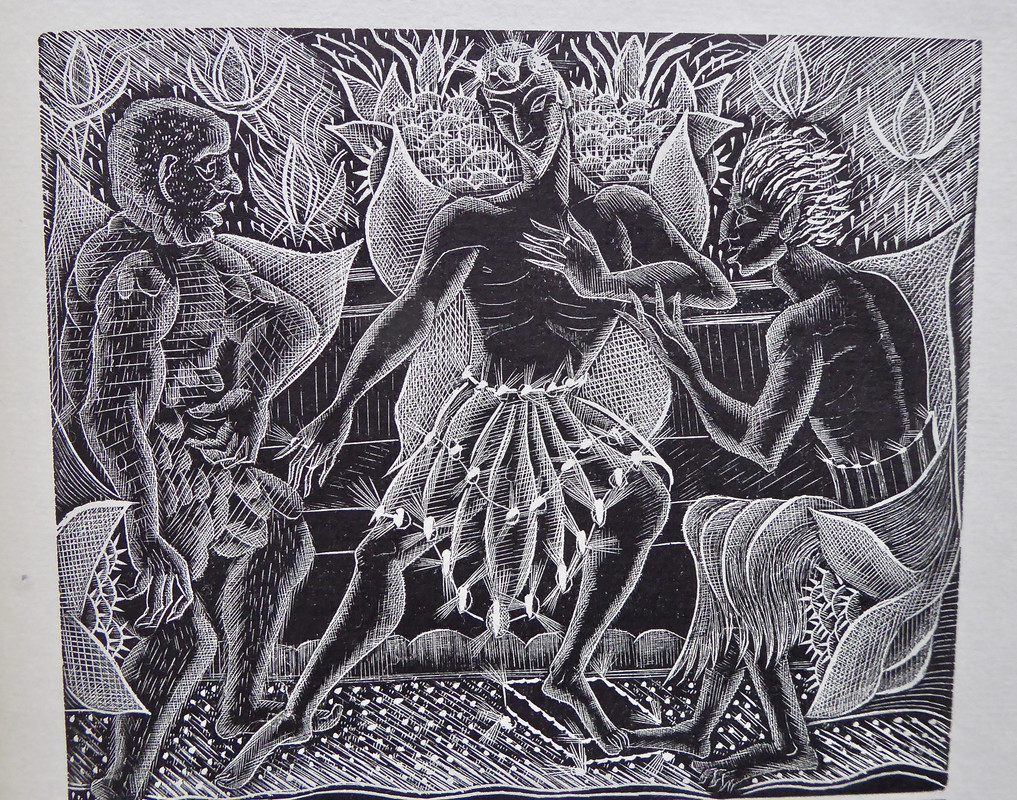
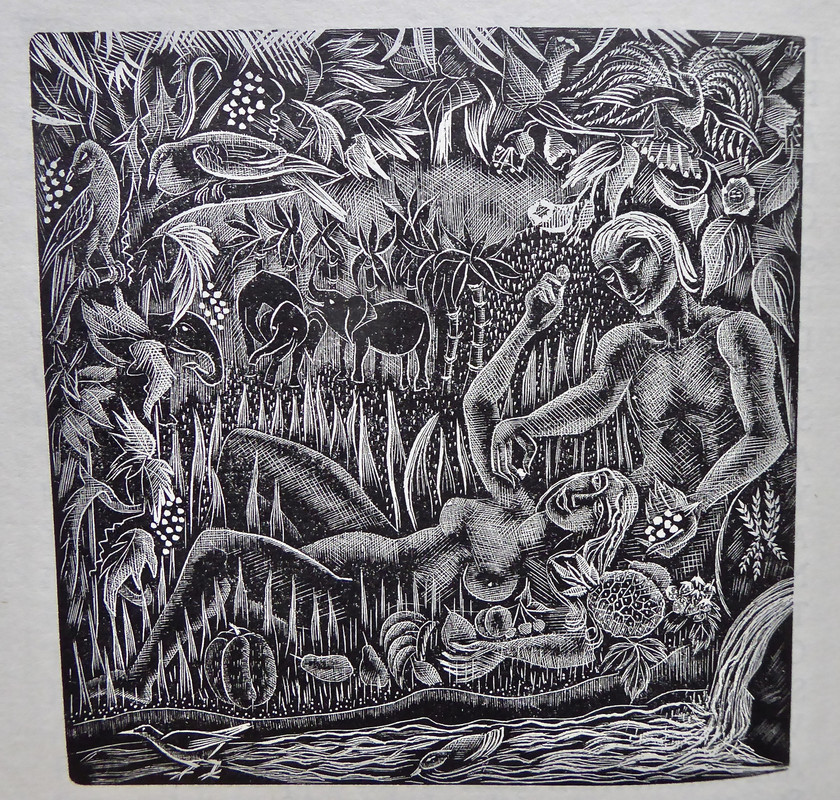
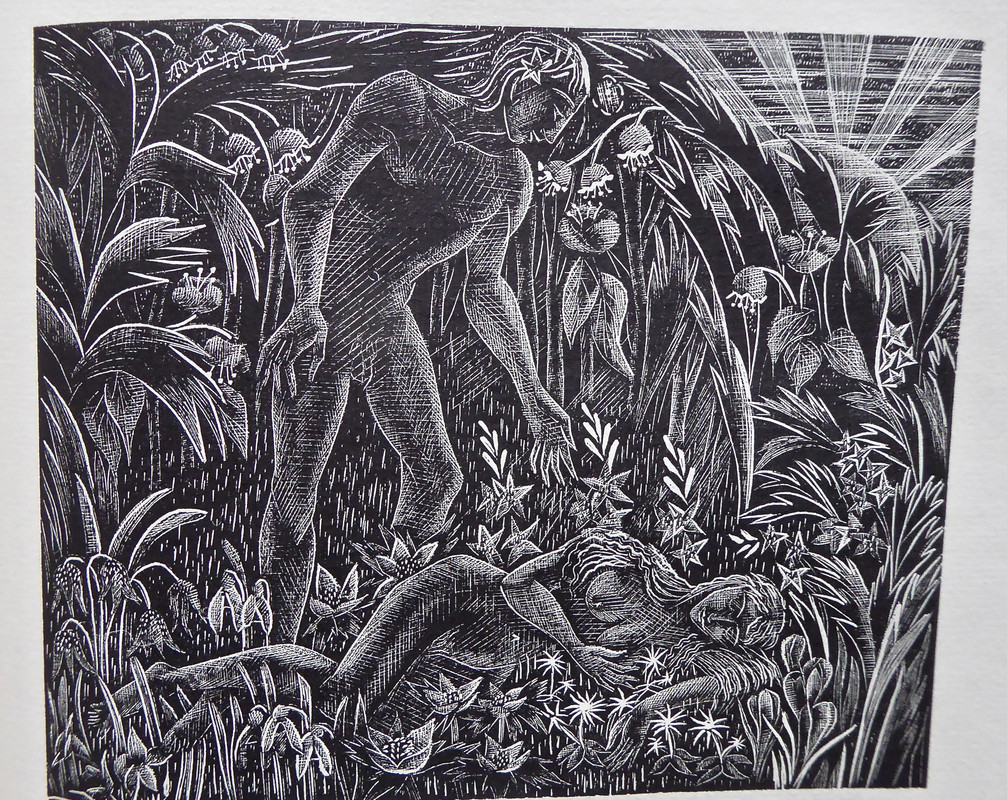
Once again, the LT Fine Press Forum cognoscenti made quick work of my latest post featuring The Great Illustrated Press Books #9 - the Clover Hill Editions & Rampant Lions Press edition of 'The Story of Cupid and Psyche'. Well, if at first you don't succeed........
The following book is not often seen in the secondary market and there is a better than even chance none of you possess a copy to identify this twentieth-century private press classic quickly or easily. The illustrations themselves will not prove helpful in this regard because they do not readily suggest the work it is illustrating.
Here goes.............




2ultrarightist
I have no idea, but I am very curious about this one. I really like the illustrations.
3Flaubie
Golden Cockerel Paradise Lost? I don't have it, but I think you have mentioned it on this board before.
5SebRinelli
Yes, that's the Golden Cockerel's Paradise Lost. I don't own a copy but it's high on my wish list.
6kdweber
I have to agree with everyone else, it's absolutely the Golden Cockerel's Paradise Lost. The first image is from page 16.
7dpbbooks
The wood engraved title by Robert Gibbings. The text engravings are by Mary Groom, with the text designed by Christopher and Anthony Sandford, Francis Newbery and Owen Rutter. Batchelor hand-made paper. Original binding by Zaehnsdorf.
This edition was limited to 200 copies, numbers 1-5 appearing on vellum.
Last image is page 135, and the prior image at page 110.
This edition was limited to 200 copies, numbers 1-5 appearing on vellum.
Last image is page 135, and the prior image at page 110.
8dlphcoracl
>3 Flaubie:
>4 MobyRichard:
>5 SebRinelli:
>6 kdweber:
>7 dpbbooks:
You are no fun whatsoever!
Once again, you have quickly made the correct response. Incidentally, do any of you actually own a copy? From the specificity of the post it appears as if >7 dpbbooks: has "book in hand". Regardless, I will complete this latest installation of TGIPPB # 10 sometime over the remainder of the week with additional photographs of Mary Groom's remarkable wood engravings and a few comments regarding my impressions of the Golden Cockerel Press, with a few suggestions pertinent to collecting.
>4 MobyRichard:
>5 SebRinelli:
>6 kdweber:
>7 dpbbooks:
You are no fun whatsoever!
Once again, you have quickly made the correct response. Incidentally, do any of you actually own a copy? From the specificity of the post it appears as if >7 dpbbooks: has "book in hand". Regardless, I will complete this latest installation of TGIPPB # 10 sometime over the remainder of the week with additional photographs of Mary Groom's remarkable wood engravings and a few comments regarding my impressions of the Golden Cockerel Press, with a few suggestions pertinent to collecting.
9dpbbooks
I wish. I do not have book in hand. Have good sources though! The only Golden Cockerel book I currently have in the collection is the Eric Gill Song of Songs: Called by many The Canticle of Canticles.
These are fun. Thank you!
These are fun. Thank you!
10kdweber
Nope. My only "real" Golden Cockerel book is Arnold Bennett's The Bright Island from 1924 bound in limp vellum.
11dlphcoracl
Paradise Lost by John Milton, Golden Cockerel Press, 1937. One of 200 copies. Illustrated with 30 engravings by Mary Groom.
Random thoughts:
Paradise Lost is Private Press Royalty, i.e., a work of literature that has received the private press treatment numerous times, almost always to pleasing effect. Wonderful editions can be found in a very wide price range starting at the lower end of the scale with a splendid 2-volume set by the Folio Society which featured reproductions of John Martin's classic 19th-Century illustrations and a commentary volume to the high end with editions from the Arion Press (which pays homage in size and style to John Baskerville's classic editions of 1758/1759), the Doves Press, the Cresset Press, and the Golden Cockerel Press (GCP). However, nothing approaches the GCP edition with Mary Groom's startling and semi-erotic wood engravings.
In the realm of illustrated modern private press books (1890-present day) there are a handful with illustrations representing a once-in-a-lifetime inspiration from an artist and book illustrator, a book which the artist was born to illustrate, with illustrations that are so inspired they become inseparable from the work. It becomes difficult to visualize the work without these illustrations. Some examples that immediately come to mind:
1. Gulliver's Travels by Jonathan Swift, Cresset Press, 1930. With Rex Whistler's Rococo-inspired illustrations.
2. The Four Gospels of the Lord Jesus Christ, Golden Cockerel Press, 1931. With Eric Gill's 64 powerful, dramatic wood-engraved initial letters and illustrations.
3. The Golden Cockerel Mabinogion, translators Gwyn Jones and Thomas Jones, Golden Cockerel Press, 1948. With Dorothea Braby's elaborate Celtic-inspired illustrations.
4. The Fables of Esope, Gregynog Press, 1931. Wood engravings by Agnes Miller Parker.
You get the idea. And Mary Groom's set of wood-engravings for the GCP edition of Milton's Paradise Lost certainly belong in this pantheon of inspired book illustration.
The Golden Cockerel Press, along with the Rampant Lions Press, were the two dominant private presses in Great Britain throughout the twentieth century. Both were prolific and long-lived with the GCP bibliography containing over two-hundred editions. However, I have a mild love-hate relationship with the GCP because:
1. Many of their editions are somewhat British-centric, featuring authors well known to the U.K. readership that either didn't travel well Across the Pond or haven't aged well and are little read in the 21st-century, or..........
2. Quirky titles of little interest to me, relatively minor works of literature or poetry or trivialities.
However, they published many splendid issues so that a healthy sampling of the GCP bibliography belongs in every modern private press collector's library. A specialty of the GCP that I DO find of great interest are their books in the Travel and Exploration genre. Many of these works originated in the days when "The Sun Never Sets on the British Empire" and several of these editions were the result of new historical research from the original logs and sources, often never previously published.
Aside from the magnificent and costly GCP/ Eric Gill trilogy of The Canterbury Tales (4-volumes), The Four Gospels and Troilus and Criseyde, what are the GCP books in the next tier? Which GCP titles are truly special and well worth seeking out as great examples of The Arts of the Book? My suggestions:
1. The Mabinogion.
2. The True Historie of Lucian the Samosatenian
3. Crusader Castles by T.E. Lawrence, 2-volumes.
4. The Voyage of the Challenger by Herbert Swire, 2-volumes. This is arguably the finest of the GCP books in the Travel & Exploration and/or historical genre, taken from Swire's original log and diaries, detailing the Voyager's circumnavigation around the globe from 1872-1876, with careful reproduction (in color!!) of Swire's sketches and drawings from his log and diaries.
And now, time for some additional illustrations from Mary Groom's GCP Paradise Lost masterpiece.



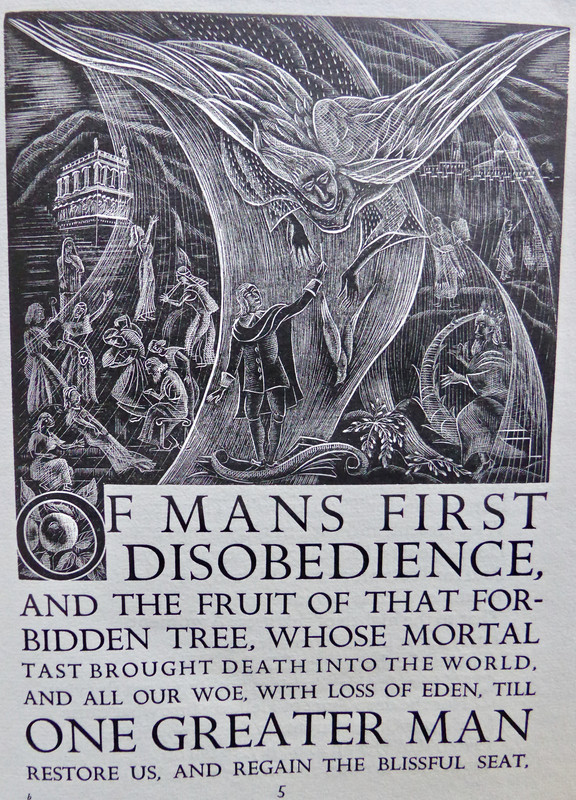
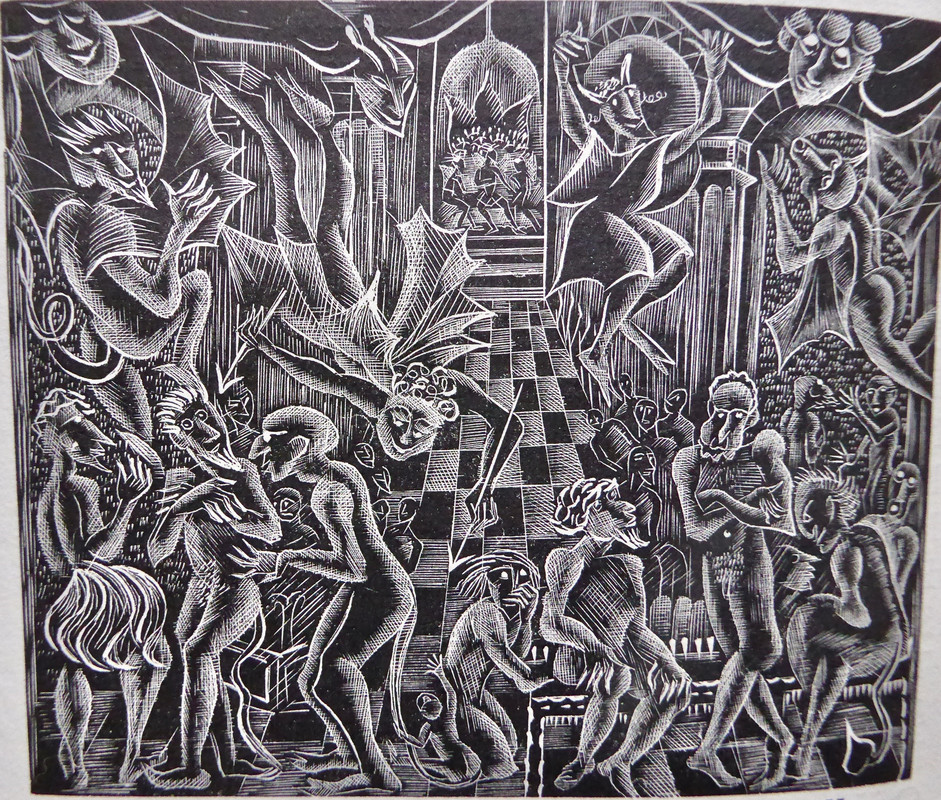
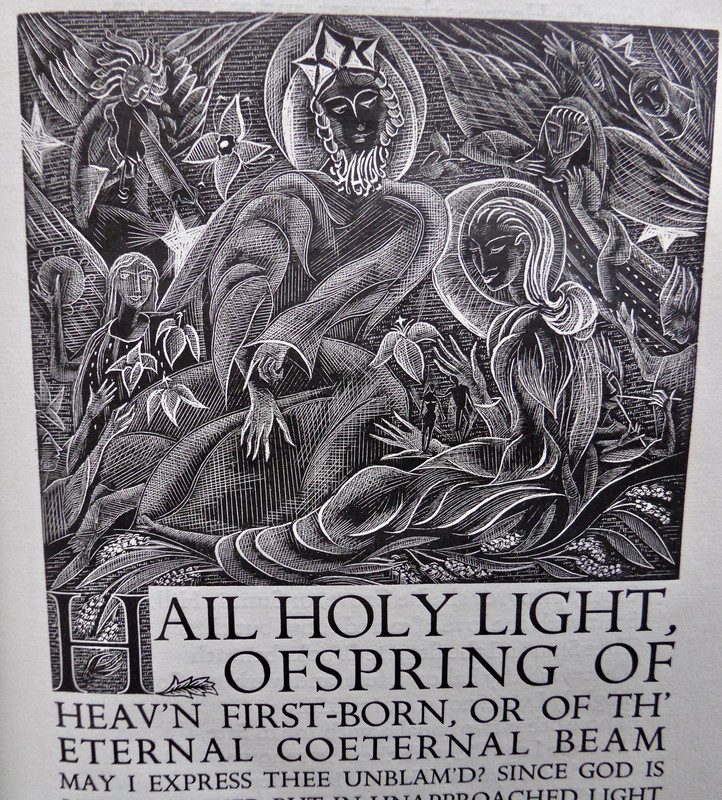
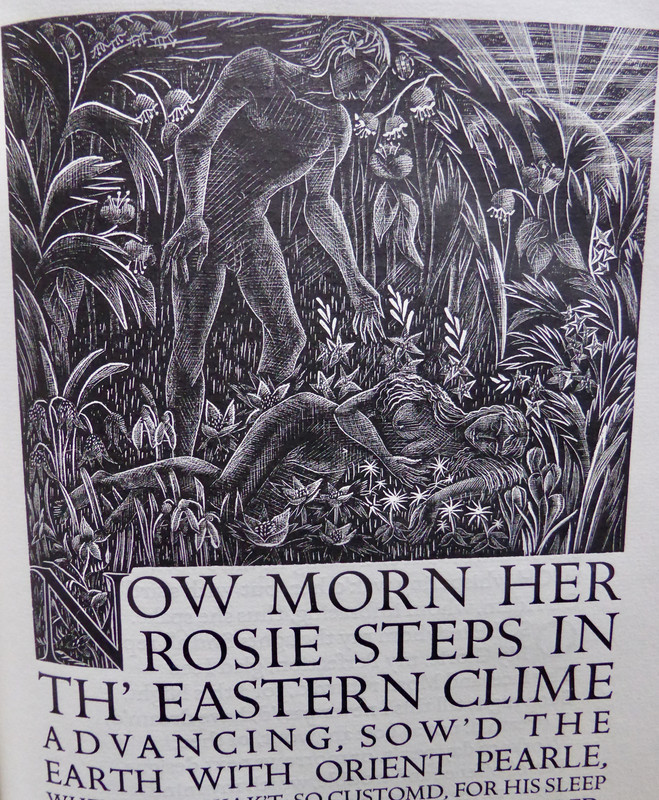
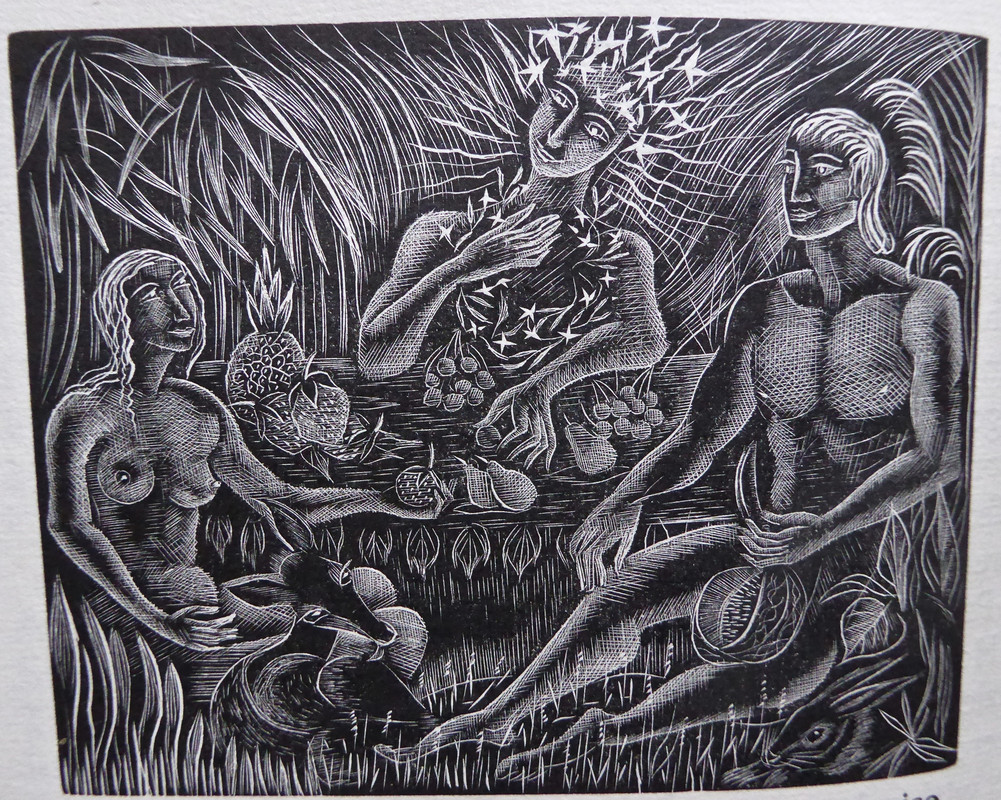
Random thoughts:
Paradise Lost is Private Press Royalty, i.e., a work of literature that has received the private press treatment numerous times, almost always to pleasing effect. Wonderful editions can be found in a very wide price range starting at the lower end of the scale with a splendid 2-volume set by the Folio Society which featured reproductions of John Martin's classic 19th-Century illustrations and a commentary volume to the high end with editions from the Arion Press (which pays homage in size and style to John Baskerville's classic editions of 1758/1759), the Doves Press, the Cresset Press, and the Golden Cockerel Press (GCP). However, nothing approaches the GCP edition with Mary Groom's startling and semi-erotic wood engravings.
In the realm of illustrated modern private press books (1890-present day) there are a handful with illustrations representing a once-in-a-lifetime inspiration from an artist and book illustrator, a book which the artist was born to illustrate, with illustrations that are so inspired they become inseparable from the work. It becomes difficult to visualize the work without these illustrations. Some examples that immediately come to mind:
1. Gulliver's Travels by Jonathan Swift, Cresset Press, 1930. With Rex Whistler's Rococo-inspired illustrations.
2. The Four Gospels of the Lord Jesus Christ, Golden Cockerel Press, 1931. With Eric Gill's 64 powerful, dramatic wood-engraved initial letters and illustrations.
3. The Golden Cockerel Mabinogion, translators Gwyn Jones and Thomas Jones, Golden Cockerel Press, 1948. With Dorothea Braby's elaborate Celtic-inspired illustrations.
4. The Fables of Esope, Gregynog Press, 1931. Wood engravings by Agnes Miller Parker.
You get the idea. And Mary Groom's set of wood-engravings for the GCP edition of Milton's Paradise Lost certainly belong in this pantheon of inspired book illustration.
The Golden Cockerel Press, along with the Rampant Lions Press, were the two dominant private presses in Great Britain throughout the twentieth century. Both were prolific and long-lived with the GCP bibliography containing over two-hundred editions. However, I have a mild love-hate relationship with the GCP because:
1. Many of their editions are somewhat British-centric, featuring authors well known to the U.K. readership that either didn't travel well Across the Pond or haven't aged well and are little read in the 21st-century, or..........
2. Quirky titles of little interest to me, relatively minor works of literature or poetry or trivialities.
However, they published many splendid issues so that a healthy sampling of the GCP bibliography belongs in every modern private press collector's library. A specialty of the GCP that I DO find of great interest are their books in the Travel and Exploration genre. Many of these works originated in the days when "The Sun Never Sets on the British Empire" and several of these editions were the result of new historical research from the original logs and sources, often never previously published.
Aside from the magnificent and costly GCP/ Eric Gill trilogy of The Canterbury Tales (4-volumes), The Four Gospels and Troilus and Criseyde, what are the GCP books in the next tier? Which GCP titles are truly special and well worth seeking out as great examples of The Arts of the Book? My suggestions:
1. The Mabinogion.
2. The True Historie of Lucian the Samosatenian
3. Crusader Castles by T.E. Lawrence, 2-volumes.
4. The Voyage of the Challenger by Herbert Swire, 2-volumes. This is arguably the finest of the GCP books in the Travel & Exploration and/or historical genre, taken from Swire's original log and diaries, detailing the Voyager's circumnavigation around the globe from 1872-1876, with careful reproduction (in color!!) of Swire's sketches and drawings from his log and diaries.
And now, time for some additional illustrations from Mary Groom's GCP Paradise Lost masterpiece.








12ultrarightist
>11 dlphcoracl: Very impressive. I love the illustrations. I was not even aware the GCP published an edition of Paradise Lost before this thread. I own the 2-volume FS edition with the Martin illustrations, and the Arion Press edition, but neither comes close to this.
13dlphcoracl
>12 ultrarightist:
If you own the Arion Press edition you need little else. It is elegant and understated representative of the Arion Press's finest work. It makes a perfect reading copy.
If you own the Arion Press edition you need little else. It is elegant and understated representative of the Arion Press's finest work. It makes a perfect reading copy.
14johnaba
The GCP Paradise Lost is probably the most difficult book to find for sale -- far more difficult, IMO, than the Barbarian Press Pericles or well-regarded private press books from the early 20th century.
I've only seen one copy come up for sale in the last three or four years, and it sold faster than I could grab my wallet.
I've only seen one copy come up for sale in the last three or four years, and it sold faster than I could grab my wallet.
15dlphcoracl
>14 johnaba:
It is indeed quite difficult to find a copy of the GCP Paradise Lost and even more difficult to find one in collectible (VG++ or NF) condition (note: I have never seen a copy in fine condition). The black leather is pigskin rather than morocco (goatskin) and it wears and ages poorly, frequently drying and cracking. The marbled paper over boards by Sydney Cockerell is also quite fragile, prone to scratching, rubbing and paper loss.
I have seen it appear at auction three times over the past decade with a superb copy offered by PBA Galleries on 11/21/2013 (see link), selling for $3,300. as that time. With prices for the most sought after private press books skyrocketing over the past 2-3 years I am certain it would sell for a higher price if it were to appear today. The difficulty in finding this book is twofold: it has a small limitation of 200 copies and it is probably the most sought after GCP book after the GCP/Eric Gill trilogy.
https://www.pbagalleries.com/view-auctions/catalog/id/140/lot/96400/Paradise-Los...
It is indeed quite difficult to find a copy of the GCP Paradise Lost and even more difficult to find one in collectible (VG++ or NF) condition (note: I have never seen a copy in fine condition). The black leather is pigskin rather than morocco (goatskin) and it wears and ages poorly, frequently drying and cracking. The marbled paper over boards by Sydney Cockerell is also quite fragile, prone to scratching, rubbing and paper loss.
I have seen it appear at auction three times over the past decade with a superb copy offered by PBA Galleries on 11/21/2013 (see link), selling for $3,300. as that time. With prices for the most sought after private press books skyrocketing over the past 2-3 years I am certain it would sell for a higher price if it were to appear today. The difficulty in finding this book is twofold: it has a small limitation of 200 copies and it is probably the most sought after GCP book after the GCP/Eric Gill trilogy.
https://www.pbagalleries.com/view-auctions/catalog/id/140/lot/96400/Paradise-Los...
16ultrarightist
>13 dlphcoracl: I agree, the AP edition is the perfect reading copy.
17EclecticIndulgence
I own two 'real' Golden Cockerel books (I ignore the LEC Cricket on the Hearth, for example), but neither have full page, half page or vignette illustrations. Was there a specific time (ownership change, after certain financial success, etc) in the publisher's history where they focused more on the quality and opulence of their illustrations?
I am fortunate enough to own the Daphnis and Chloe, as well as Swift's Directions to Servants, the latter with 12 'decorations' by John Nash. Neither can hold even a quarter of a candle to this Paradise Lost.
I am fortunate enough to own the Daphnis and Chloe, as well as Swift's Directions to Servants, the latter with 12 'decorations' by John Nash. Neither can hold even a quarter of a candle to this Paradise Lost.
18dlphcoracl
>17 EclecticIndulgence:
Although founded in 1920, the Golden Cockerel Press really found its way when Robert Gibbings bought the struggling private press in 1924. Gibbings himself was an accomplished wood engraver and under his direction the GCP became a platform for the most gifted wood engravers in the United Kingdom to exhibit their artistry through the medium of book illustration. From 1924 on, full page woodcuts and wood engravings were an essential aspect of GCP editions. Simultaneously, they also refocused their efforts on superb letterpress printing on a variety of fine handmade papers.
If neither of your two GCP books "can hold even a quarter of a candle to this Paradise Lost" there is a good explanation for this. It is because the GCP Paradise Lost with the Anna Groom wood engravings is probably the finest GCP edition after the famous GCP/Eric Gill trilogy of books (the Canterbury Tales, Troilus and Criseyde and The Four Gospels). It is certainly the most sought after by GCP and modern private press book collectors and because of its very low limitation it rarely appears on the secondary market. When it does appear in collectible (near fine) condition it is exceedingly expensive.
Although founded in 1920, the Golden Cockerel Press really found its way when Robert Gibbings bought the struggling private press in 1924. Gibbings himself was an accomplished wood engraver and under his direction the GCP became a platform for the most gifted wood engravers in the United Kingdom to exhibit their artistry through the medium of book illustration. From 1924 on, full page woodcuts and wood engravings were an essential aspect of GCP editions. Simultaneously, they also refocused their efforts on superb letterpress printing on a variety of fine handmade papers.
If neither of your two GCP books "can hold even a quarter of a candle to this Paradise Lost" there is a good explanation for this. It is because the GCP Paradise Lost with the Anna Groom wood engravings is probably the finest GCP edition after the famous GCP/Eric Gill trilogy of books (the Canterbury Tales, Troilus and Criseyde and The Four Gospels). It is certainly the most sought after by GCP and modern private press book collectors and because of its very low limitation it rarely appears on the secondary market. When it does appear in collectible (near fine) condition it is exceedingly expensive.
19Glacierman
>17 EclecticIndulgence: However, if you can't find a GCP Paradise Lost, you can get their Grecian Enchanted instead and settle for a lesser, if no less satisfying work.
20bookist
This is what the partners of the Golden Cockerel Press, Christopher Sandford and Owen Rutter, had to say about their 1937 edition of Paradise Lost 6 years later:
"This volume took so long in preparation that by the time it was ready for publication, we recognized, in the light of experience, several improvements which could have been made. The displayed titling with which each book opened should have been centred on the page: it did not balance, nor read any too well, and the artist did not achieve a sufficient co-ordination between the head-pieces, with their dropped initial letters, and the rest of the titling. Of course we had Eric Gill’s Four Gospels in mind when we proposed this style of heading and, to a lesser degree, the chapter openings which had proved so successful in The Journal of James Morrison. We should have recognized that Mary Groom’s style, so divergent from that of Gill & Gibbings, was not entirely suited to this style of display.
"But, in spite of all defects, the vellums of this Paradise Lost are, we think, exceptionally beautiful books; and we also thought the bindings of the ordinaries an exciting and artistically pleasing complement to the descriptions of the ‘lake of fire’ which bulk so largely in the first half of the poem.
"As to the illustrations, we find these extremely interesting and refreshingly original. To be very critical, they are perhaps too reminiscent of the Flemish primitives correctly to accord with the renaissant semi-sophistication of Milton’s poetry.
"As to the type, this was the first appearance as a medium for the portrayal of poetry of the 18pt. Golden Cockerel type designed for this press by Eric Gill. We know all types that have been, and say without hesitation that for dignity and virile beauty this face has no peer.
"Lastly, we dare any expert printer to find fault with our presswork in this book."
Incidentally, the original design for a Golden Cockerel Paradise Lost had a very different look. This single page appeared in a prospectus in 1930:

The illustration is by Robert Gibbings, who ran the press from 1924 to 1933. He postponed and then abandoned his Paradise Lost, deciding that the poem was “not entirely suited to his muse”.
"This volume took so long in preparation that by the time it was ready for publication, we recognized, in the light of experience, several improvements which could have been made. The displayed titling with which each book opened should have been centred on the page: it did not balance, nor read any too well, and the artist did not achieve a sufficient co-ordination between the head-pieces, with their dropped initial letters, and the rest of the titling. Of course we had Eric Gill’s Four Gospels in mind when we proposed this style of heading and, to a lesser degree, the chapter openings which had proved so successful in The Journal of James Morrison. We should have recognized that Mary Groom’s style, so divergent from that of Gill & Gibbings, was not entirely suited to this style of display.
"But, in spite of all defects, the vellums of this Paradise Lost are, we think, exceptionally beautiful books; and we also thought the bindings of the ordinaries an exciting and artistically pleasing complement to the descriptions of the ‘lake of fire’ which bulk so largely in the first half of the poem.
"As to the illustrations, we find these extremely interesting and refreshingly original. To be very critical, they are perhaps too reminiscent of the Flemish primitives correctly to accord with the renaissant semi-sophistication of Milton’s poetry.
"As to the type, this was the first appearance as a medium for the portrayal of poetry of the 18pt. Golden Cockerel type designed for this press by Eric Gill. We know all types that have been, and say without hesitation that for dignity and virile beauty this face has no peer.
"Lastly, we dare any expert printer to find fault with our presswork in this book."
Incidentally, the original design for a Golden Cockerel Paradise Lost had a very different look. This single page appeared in a prospectus in 1930:

The illustration is by Robert Gibbings, who ran the press from 1924 to 1933. He postponed and then abandoned his Paradise Lost, deciding that the poem was “not entirely suited to his muse”.
21Nightcrawl
>20 bookist: That is…really cool! Thanks for sharing!
22dlphcoracl
>20 bookist:
I am relieved Robert Gibbings abandoned illustrating the GCP Paradise Lost and left it to Mary Groom because the wood engraving above looks more like a Tahitian native than Eve in the Garden of Eden.
I am relieved Robert Gibbings abandoned illustrating the GCP Paradise Lost and left it to Mary Groom because the wood engraving above looks more like a Tahitian native than Eve in the Garden of Eden.

